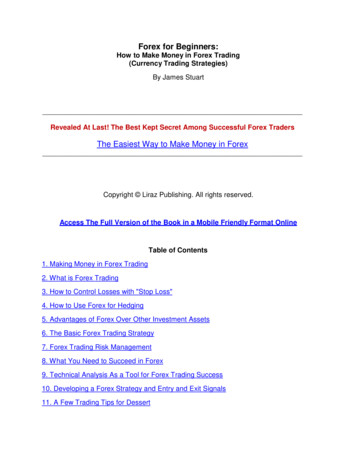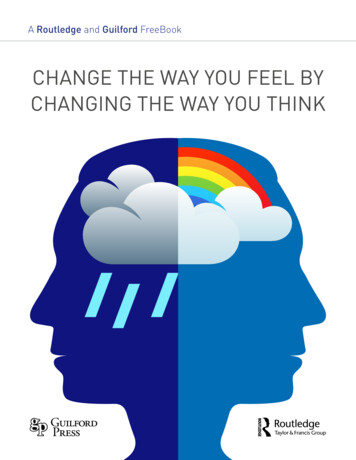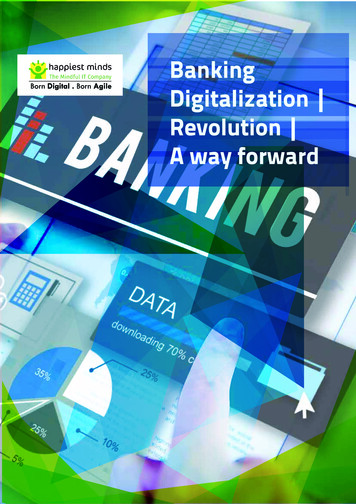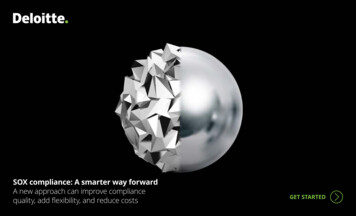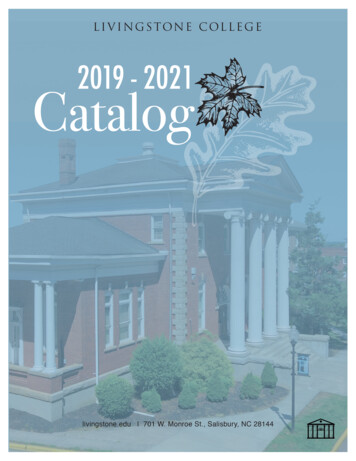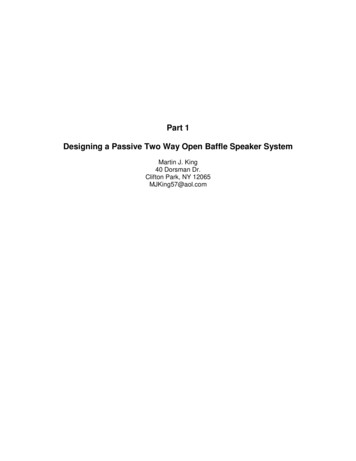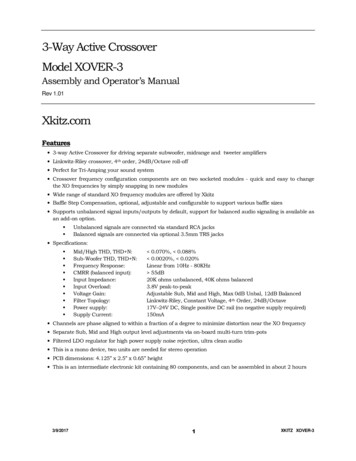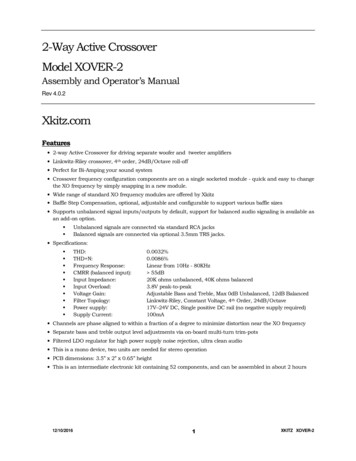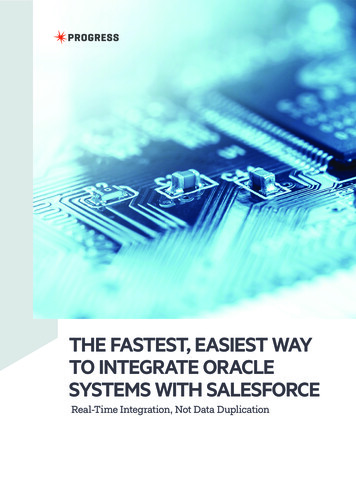
Transcription
THE FASTEST, EASIEST WAYTO INTEGRATE ORACLESYSTEMS WITH SALESFORCEReal-Time Integration, Not Data Duplication
Salesforce may be called the “Customer Success Platform,” butsuccess with this CRM is highly dependent on access to theright data. Not all customer data lives in Saleforce. For manycompanies, data resides in backend systems and data sourcesbeyond Salesforce—Oracle databases and applications such asSiebel CRM, JD Edwards Enterprise One, E-Business Suite andPeoplesoft Enterprise, as well as data warehouses using Oracleas a data source.For years, IT architects faced the challenge of creating realtime connections across numerous siloed applications—anissue that has delayed progress for enterprises hoping to drivenew business, serve customers better and streamline businessprocesses. Most companies want their IT department focused ondelivering innovation, not integration. In short, they need an easyway to access Oracle data from the Salesforce platform.48%of CIOssay dataintegrationis their #1challenge 1Salesforce Research conducted byindependent third-party, Confirmit1This whitepaper explores the advantages of implementing a realtime Salesforce data integration strategy for companies runningOracle databases and applications.Traditional Approaches toSalesforce Data IntegrationTraditional data integration, or ETL (extract, transform and load), requires moving, copying andsynchronizing data. The challenge in this strategy is integrating large volumes of data that maybe out of date before the process is finished. Other integration approaches require extensivedevelopment projects to build web service callouts from Salesforce, and bridge them togetherwith middleware.Both strategies are outside the realm of the Salesforce CRM group, which may feel pressure todeliver data-driven features to their Salesforce users. Most importantly, such approaches inhibitthe Salesforce team’s ability to be agile with changes, because of dependency on outside teams.Progress.com2
The Challenge ofIntegrating Legacyand Cloud SystemsCompanies want everything they need to be inSalesforce, but many struggle with integrating legacyand cloud systems because it’s expensive, timeconsuming and a burden on IT resources. They don’twant to worry about where data is anymore. Theydon’t want to disrupt business processes. And, theydon’t want to copy or store data inside Salesforce.They need an easier approach that leaves systemsof record intact while integrating that data in realtime with Salesforce. According to Gartner, “Moreorganizations are demanding that data be deliveredor processed in real time to match the speed of theirbusiness. They expect reduced latency and real-timedata delivery.” 2“More organizations are demandingthat data be delivered or processed inreal time to match the speed of theirbusiness.”What’s needed is a painless Oracle data integrationstrategy that offers plug-and-play compatibility withthe Salesforce ecosystem.GartnerGartner, “The State of Data Integration: Current Practices and Evolving Trends,”Eric Thoo, Ted Friedman, Mark A. Beyer, 03 April 2014.2Progress.com3
Salesforce Connect and ODataHow can companies create real-time dataintegration without a huge developmenteffort? This is accomplished first throughSalesforce Connect (formerly “SalesforceLightning Connect”), an integration strategyfrom Salesforce launched in 2014. Usingindustry standard Open Data Protocol(OData), Salesforce Connect provide a wayfor any external data to be integrated intoSalesforce, as long as the data is accessiblevia OData. No coding is required.According to Larry Carvalho, research manager forplatform-as-a-service (PaaS) at market research firmIDC, Salesforce is addressing an issue that’s beenhindering progress in enterprises for years: “Addressingthe severe shortage of developers through automationof the application development lifecycle is an importantdifferentiator and the whole IT market could benefitfrom such initiatives. Salesforce is addressing the needfor connecting multiple applications by capabilitieswithin their own product, which helps their customersgain efficiency.” 3“Salesforce is addressing theneed for connecting multipleapplications by capabilitieswithin their own product,which helps their customersgain efficiency.”Larry Carvalho, IDCHowever, Salesforce Connect by itself does not providethe required OData connectivity to Oracle databasesand applications; nor do Oracle applications providenative support for OData. As such, in addition toSalesforce Connect, companies need a solution thatexposes Oracle data in an OData-compatible way.Jessica Davis, “Salesforce Connect Opens App Dev To Non-Coders,” 23 December 2015, InformationWeek, ders/d/d-id/1323395 3Progress.com4
Why OData?Originally developed by Microsoft, and subsequently adopted as an OASIS standard,OData is a protocol for providing access to data over the Internet. OData is a simple,standardized way to interact with data on the web from any platform or device. It’sbuilt on the HTTP standard, JSON (a standard data exchange format) and REST (acommonly accepted methodology for working with web resources.)SaaS vendors such as Salesforce are adopting OData as an external data strategybecause of its interoperability and ability to support both on-premise and cloud datasources. OData is quickly gaining ground over traditional data integration patterns forits web-friendly approach and interoperability across a wide ecosystem of existingapplications and data sources. (See odata.org for more information on OData.)OData is quickly gaining ground over traditional data integrationpatterns for its web-friendly approach and interoperability across awide ecosystem of existing applications.Progress.com5
ODataConnectivitySolutionsBecause OData tooling is currently limited in theOracle ecosystem, companies need to find solutionsthat produce OData to be consumed by SalesforceConnect. Options for supplying the necessary ODataconnectivity include do-it-yourself projects, third-partymiddleware software or OData connectivity solutions.IT can custom-build an OData producer andconnectivity into Salesforce for each Oracleapplication or data source. However, an internal doit-yourself solution such as this could take monthsof dedicated development effort, often resulting ina brittle integration with no guarantee of success orscalability. Third-party middleware solutions requirelicensing, installing and configuring additional softwarecomponents. With both options, you must still traversethe firewall to expose the data to Salesforce. Thefirewall adds a layer of complexity that necessitatesnetwork and security expertise.Because OData tooling is currentlylimited in the Oracle ecosystem,companies need to find solutions thatproduce OData to be consumed bySalesforce Connect.Fortunately, new technology offers a more efficient,cost-effective option: Real-time OData connectivitysolutions.Progress.com6
Benefits of a Real-Time, ODataConnectivity SolutionA real-time, OData connectivity solution combines OData serviceswith built-in access to external Oracle data sources, in the cloudand on-premise. The solution exposes external Oracle data as anOData feed to Salesforce Connect in real time.An OData connectivity solution provides the quickest way toexpose Oracle data, without requiring changes to a company’sdatabases or servers, and without requiring the installation ofcomplex middleware components. This innovative technologysimplifies data integration challenges with one approach thatcan be easily repeated across use cases. The best solutions don’trequire coding and enable secure access to data behind thefirewall. And, ideally, they can be implemented without requiringmajor staff retraining.An OData connectivitysolution provides thequickest way to exposeOracle data, withoutrequiring changes to acompany’s databasesor servers, and withoutrequiring the installationof complex middlewarecomponents.Key BenefitsCompanies can expect the following benefits whenimplementing an OData connectivity solutioncombined with Salesforce Connect: Real-time access to external Oracle data:Provides a direct connection from Salesforceto Oracle ERP/CRM systems and databases,without moving or duplicating data. Salesforceusers can access external Oracle data fromwithin Salesforce. Agile environment: Improves productivity forboth developers and Salesforce administratorsimmediately, enabling them to use their existingskill sets and maintain data access easily, overtime, as systems and teams change. Hybrid connectivity: Offers access to Oracle inthe cloud and on-premise. Faster time to value: Eliminates the need forextensive integration projects or additionalmiddleware software to install and configure.Progress.com7
What to Look for in an ODataConnectivity Solution Enterprise-ready: Can the solution run reliablyand effectively within a large organizationtoday? Easy to use: Is the interface easy to understandand use by current staff? Can Salesforceadministrators use it, or do you need a specialistto code the setup? Scalability: Can the solution handle thousandsof concurrent connections and large volumes ofdata, without latency? Database support: Does the solution support awide range of Oracle applications and databaseversions to prevent implementation delays andto future-proof data integration? Impact on existing systems: Doesthe solution require changes to theinfrastructure or underlying databases, oradditional software to be installed? Security: Can the solution safely traversethe firewall to access on-premise Oracledata? Experience: Is the vendor an establishedleader in data connectivity with at least 10years of experience? Support: Can the vendor provideenterprise-class, 24/7 technical support? Proven: Is the solution proven at a largeorganization?DataDirect Cloud: A New Breed ofReal-Time Data IntegrationAn enterprise-ready OData connectivity solution, Progress DataDirect Cloud provides the quickest way to integrate Oracledata in real-time via Salesforce Connect. DataDirect Cloud doesnot require any changes to a company’s databases or servers, nordoes it require installing any complex middleware components.DataDirect Cloud empowers Salesforce teams with a simple dataintegration strategy that promotes speed and agility.Progress.com8An enterprise-readyOData connectivitysolution, DataDirectCloud provides thequickest way to integrateOracle data in real time,via Salesforce Connect.
AdvantagesDataDirect Cloud is designed and developedby Progress, the recognized leader in dataconnectivity and integration for more than 30years. Providing data connectivity for more than140,000 enterprises and over 5,000 independentsoftware products, Progress has established anunparalleled customer base worldwide.DataDirect Cloud provides the following uniqueadvantages: Enterprise-ready solution: DataDirect Cloud isextremely scalable and already in production atlarge enterprises, supporting thousands of userswith direct, real-time connections to OracleProgress is also known for its responsive, awardwinning technical support. In addition, Progresshas an ongoing partnership with Oracle, and isa member of TSANet, a multi-vendor supportcommunity, including Oracle. This simplifiescomplex, multi-vendor troubleshooting. Progressis also a voting member of the OData/OASISstandards committee. Wide breadth of Oracle version support:Salesforce teams can get up and running quickly,ensuring support for both newer and olderversions of Oracle Support for multiple endpoints: OneSalesforce Connect license supports multipleOracle databases via DataDirect Cloud to saveon licensing costsKey Features “Clicks, Not Code” interface: Makesdevelopers and Salesforce administratorsproductive immediately using existing skills, andmore agile for future integrations “Clicks, not Code” setup Supports Oracle 8i through 12c Access to data inside the firewall: DataDirectCloud safely exposes Oracle data behindthe firewall as an OData feed that SalesforceConnect can consume, without time-consumingfirewall engineering Supports Oracle Service Cloud(RightNow) and Oracle Marketing Cloud(Eloqua) Supports Oracle in the cloud or onpremise behind the firewall No infrastructure changes: A cloud-baseddata connectivity service, DataDirect Clouddoesn’t require modifications to the database orinstallation of complex middleware One Salesforce Connect license supportsmultiple Oracle endpoints Leverages full text search for more Enterprise-class technical support: DataDirectCloud includes 24/7 “follow the sun” technicalsupport via telephone, web or emailefficient queries Supports read/write operationsProgress.com9
How DataDirect Cloud WorksDataDirect Cloud is a connectivityservice that provides an ODatainterface and access to multipleversions of Oracle. This interfaceenables Salesforce to connect tothe Oracle data sources exposedby the service. DataDirect Cloudaccepts OData statements,translates them to SQL, thenforwards the SQL to the backendOracle data source to be executed.Configuring the connection to Oracle through DataDirect Cloud is simple:1. Define the target data source(s) in DataDirect Cloud. (To set up a data source for data stores behind afirewall, install and configure the On-Premise Connector.)2. Specify which tables to expose via OData.3. In Salesforce Connect, define the external data source by pointing to the address for the OData serviceassociated with this data source.4. Synchronize the meta data to define the external data object.5. Access the data from within Salesforce.com.ODataProgressDataDirect CloudConnectivity ServiceLightning Connectservice requiredProgress.com10HTTP
DataDirect Cloudin ActionA leading financial solutions company needed tobring customer data from Siebel into Salesforce, toenable sales agents to better serve customers.Migrating
Salesforce Data Integration Traditional data integration, or ETL (extract, transform and load), requires moving, copying and synchronizing data. The challenge in this strategy is integrating large volumes of data that may be out of date before the process is finished. Other integration approaches require extensive development projects to build web service callouts from Salesforce, and bridge .
